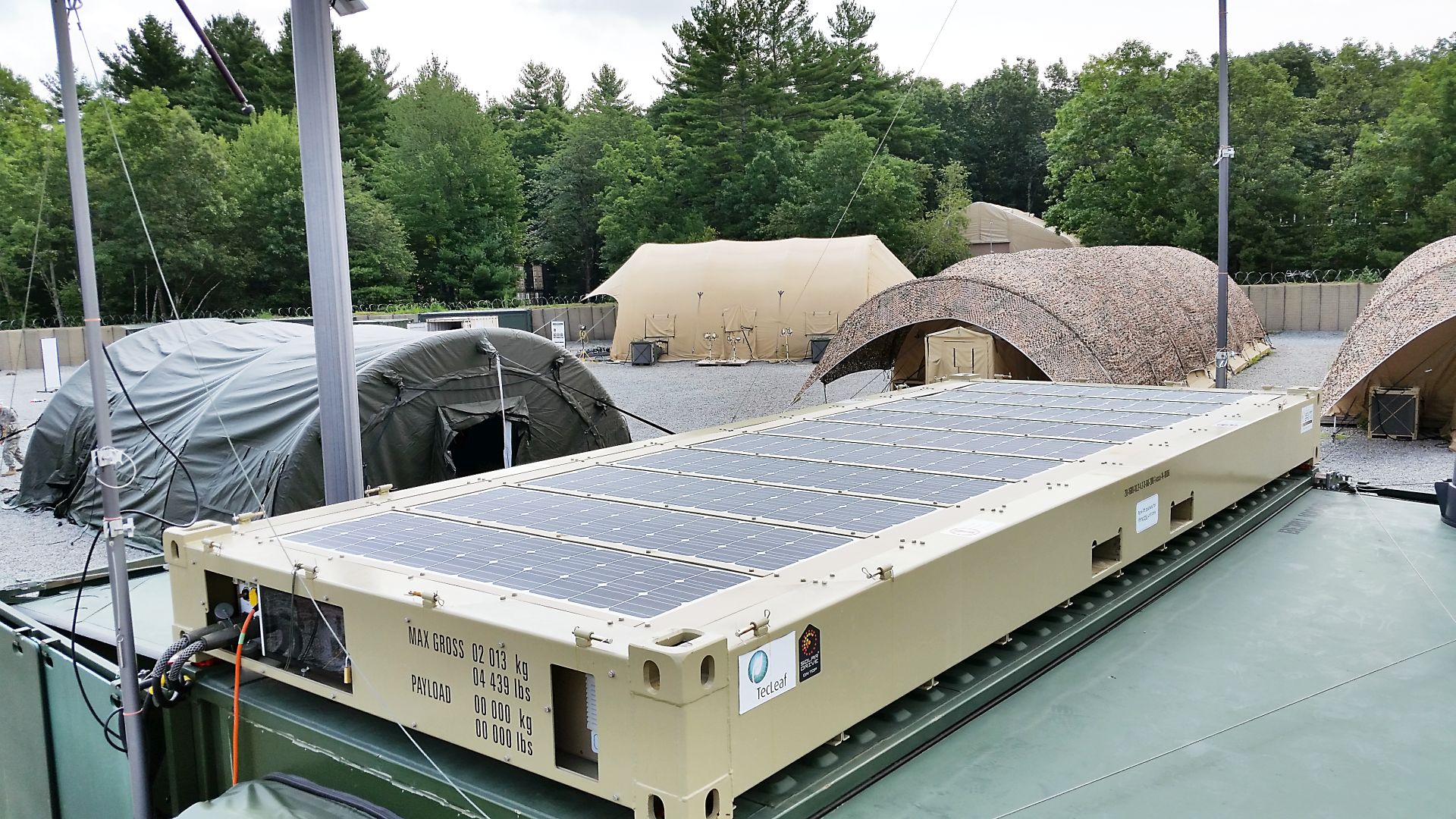U.S. military fuel convoys in combat areas present risk to Service members’ lives as well as significant transportation costs.
The Army and Navy are investigating using self-contained solar-power systems to generate energy and reduce these threats incurred through convoys on the battlefield.
“If the system eliminates one 5,000-gallon fuel trailer, we will have achieved success in improving Soldiers’ safety and mission efficiency,” said William “Randy” Everett, project manager of the Army’s Foreign Comparative Testing Program.
The goal of the Solar Power Shelter System is to minimize battlefield logistics footprints and decrease fuel-consumption costs. It uses renewable energy sources and battery storage to power military base camp equipment.
The SPSS is an integrated hybrid system that combines solar power with a standard military diesel generator to provide a continuous energy loop, said Tom Merrill, renewable energy storage lead with Army’s Product Manager Force Sustainment Systems.
The system gathers and manages energy as it collects the sun’s rays through photovoltaic panels and stores power in a battery. Once the battery power is depleted, the generator starts in order to maintain a seamless operation. A SPSS unit sits atop a military shelter or shipping container, known as a CONEX, to eliminate the need for additional ground footprint to deploy and operate the system.
“The goal is to minimize generator usage. We’re looking to decrease the dependency on fuel resources. By harvesting alternative energy, we’re able to reduce the amount of energy required from the generators and require fewer fuel convoys to save lives and money,” said Rich Guiliano, program acquisition specialist with PdM FSS.
JOINT INITIATIVE WITH NAVY
In addition to Army testing, the Navy is in the process of purchasing two 20-foot SPSS units for its Net Zero Containerized Living Unit evaluation project, Merrill said.
Operational field testing will begin in July at Camp Lemonnier in Djibouti, Africa, which has more than 600 CLUs. The Navy uses 40-foot long, non-expandable ISO containers as the building block for its CLUs.
The services are sharing test data on the SPSS from the Army’s FCT project and Navy’s Net Zero CLU project. They are also evaluating which global regions would be the most effective to place the systems depending on the amount of sunlight received.
SUPPORT FROM FOREIGN COMPARATIVE TESTING PROGRAM
While Everett was on an FCT-sponsored technology tour to Scandinavia, he met with representatives of TecLeaf, a Danish company and the manufacturer of SPSS. The company had been working with the Danish military, and Everett forwarded the SPSS technical details to PdM FSS back in the United States.
“The technology was interesting,” Everett said. “This was an emerging technology that U.S. Army program managers didn’t have the research and development dollars to test and evaluate. We wouldn’t have been able to do the project without the support and funding provided by the OSD FCT office.”
OSD FCT’s mission is to find and evaluate “here and now” solutions to meet the operational needs of American Service members so they have the technology needed to remain dominant on the battlefield — regardless of the origin of that technology.
The Department of Defense has leveraged new and evolving technology through FCT since 1980. The program encourages international cooperation and helps reduce overall DoD acquisition costs by funding the testing of foreign non-developmental items, commercial-off-the-shelf items, or those items in a late state of the development process that demonstrate the potential to satisfy the U.S. military’s needs, Everett said.
The U.S. Army Research, Development and Engineering Command’s International Cooperation and Exchange Team manages the program for the Army.
ONGOING EVALUATION OF SPSS
The U.S. Army Aberdeen Test Center at APG performed safety, environmental and transportability testing of the SPSS, which was completed in April.
“You don’t know how a system will perform until it undergoes military testing,” Merrill said. “You need to understand what Service members will and will not be able to do with the system.”
The SPSS units will now move to the Base Camp Integration Laboratory at Fort Devens, Massachusetts, this summer for further evaluation in a base camp environment.
Merrill explained the additional benefits of SPSS include space conservation and a configuration that allows ballistic panels to be added underneath the system to protect people inside the CONEX.
“You may not have a lot of room in a forward operating base, and the system does not require any additional ground footprint,” Merrill said. “We are harvesting the unused space on top of the CONEX.”
The system can also be adapted for future improvements.
“You can pull out solar panels and replace them. As the technology improves for panels and battery storage, the system is designed to receive it,” Merrill said.










